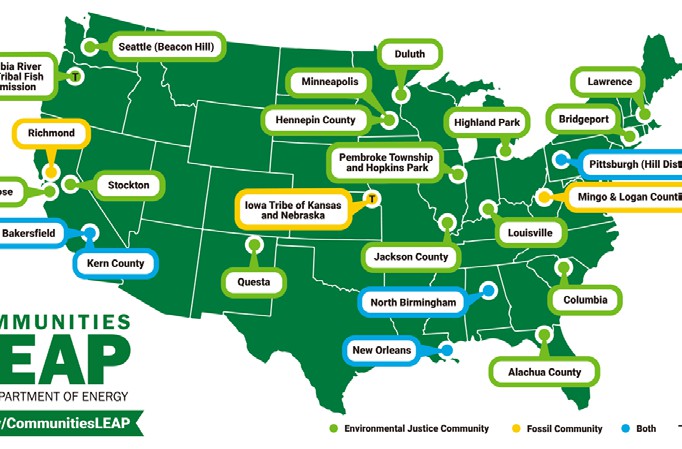Energy gaps narrowing after 2 years of clean energy programs
Climate Power US, a non-profit that advocates for clean, renewable energy, stated that since 2022, there have been 751 new clean energy projects created, which are responsible for 406,007 new, well-paying jobs, according to a recent correspondence. The pay range for these new green jobs is anywhere from 36k per year for technicians to 72k annually for engineers, according to National Renewable Energy Laboratories (NREL).
The United States Department of Energy’s (DOE’s) Communities Local Energy Action Program (Communities LEAP), which began in the Spring of 2022, has helped community leaders to launch clean, sustainable energy initiatives and realize renewable energy goals. In the final report of December 3, 2024, Communities LEAP hailed the success of their 18 month pilot program, acknowledging lessons learned and celebrating the accomplishments of Cohort 1, comprised of 24 communities in 17 states.
Communities LEAP provided 18 months of in-depth technical assistance to meet the unique challenges of each of the 24 communities, offering an additional 40-80 hours of post – project continuing technical support to ensure successful outcomes. The Cohort 1 pilot coalition consisted of the following communities:
Beacon Hill in Seattle Washington; Columbia River Inter-Tribal Fish Commission in Oregon; Richmond, San Jose, Stockton, Bakersfield, and Kern County in California; Questa, New Mexico; Iowa Tribe of Kansas and Nebraska; Hennepin County and Minneapolis, Minnesota; Highland Park, Michigan; Pembroke Township, Hopkins Park (both South of Chicago), and Jackson County in Illinois; Louisville, Kentucky; North Birmingham, Alabama; New Orleans, Louisiana; Alachua County in Northcentral Florida; Columbia, South Carolina; Mingo and Logan Counties in West Virginia; the Hill District of Pittsburgh, Pennsylvania; Bridgeport, Connecticut; and Lawrence, Massachusetts.
Two of the communities, Kern County, CA and Mingo and Logan Counties, WV, benefitted from carbon capture and storage technology offered by Lawrence Livermore National Laboratory (LLNL) and National Energy Technology Laboratory (NETL). LLNL coordinated with another technical provider (FECM) to provide direct support to both communities, while LLNL supported one community.
Sandia National Laboratories (SNL) provided technical assistance in tandem with National Renewable Energy Laboratories aligned with the Community Resilience Microgrid Pathway.
There are 7 Technical Assistance Pathways in all:
• Energy Efficient Building and Beneficial Electrification Planning and Investment
• Clean Energy and Energy Efficiency
• Clean Energy Planning and Development
• Community Resilience Microgrid
• Carbon Capture and Storage and Critical Minerals Recovery
• Clean Transportation and Investment, and
• New or Enhanced Manufacturing and Industry.
As the primary technical assistance program coordinator for Communities LEAP, National Renewable Energy Laboratories (NREL) provided expert guidance to 22 of the 24 communities, assisting coalition communities to realize long-term economic goals while providing information and technical support to help them plan for far-reaching environmental and energy security. Some of the economic benefits included developing a clean energy plan, increasing community resilience, improving energy storage capabilities, and realizing manufacturing goals.
Each of the coalition communities benefitted from the three phases of support: Phase I, tailoring support and meeting community needs; Phase II, delivering technical assistance; and Phase III, charting next steps with communities, as described in the final report (www.energy.gov/communitiesLEAP/communities-leap-pilot-final-report#p3/).
Two of the Communities LEAP pilot coalitions in Cohort 1 supported Native American initiatives, the Columbia River Inter-Tribal Fish Commission (CRITFC) and the Iowa Tribe of Kansas and Nebraska.
CRITFC in Washington State is a tribal affiliation that seeks to protect treaty-established fishing rights of the Nez Perce, Umatilla, Warm Springs, and Yakima tribes, as well as fish habitat along the Columbia River ecosystem. Community leads for the project are Anthony Teixeira and Thushara DeSilva. Hydroelectric dams along the Columbia River basin substantially impact fish habitat and obstruct treaty rights. The Pacific Northwest tribes have spent many years organizing to protect salmon and other river run fish in the region. As in Maine, where the Penobscot Indian Nation along with multiple community organizations fought for decades to affect the removal of hydroelectric dams or diverting waterways around them, so CRITFC has struggled to find alternatives to hydroelectric power. The Penobscot and other groups negotiated with a regional utility to realize long term goals, while the Yakima and Pacific Northwest tribes have faced similar challenges.
The needs of CRITFC centered around power grid modeling tools to analyze hydropower generation and grid operations. The modeling tools would generate data, graphs, and charts in support of goals to develop two potential renewable energy plans distinguished by differing attributes such as weather conditions, terms for hydropower operation, and infrastructure. The information generated will empower tribal representatives to participate effectively in multi-stakeholder environmental decision-making processes, in which input of tribes is essential and also support CRITFC’s 2022 Energy Vision for alternative renewable energy.
Iowa Tribe of Kansas and Nebraska community leads are Hallie Lucas and Tony Jimenez. ITKN is a rural community situated on both sides of the border between northeastern Kansas and southeastern Nebraska along the Missouri River. Plagued with unsustainably high utility costs and constant threats of long power outages, the needs of the ITKN community centered around energy security. The goals of ITKN were to establish a tribal utility authority around solar energy and create a microgrid to facilitate energy sovereignty. Technical assistance provided ITKN with the information required to build a microgrid system which in turn created opportunities for the local workforce, also trained by way of technical support.
According to the final report, as the 18 month pilot project comes to a close, already 14 coalitions have secured more than $30 million in additional funding to further their efforts, building on the technical assistance and information they acquired in the program. Part of the assistance received was to find additional sources of funding for future projects. By March 2024 another 30 new communities were selected to participate in Cohort 2 for the next cycle of the Communities LEAP program.
(Contact Aliyah Keuthan at kretreldancing@gmail.com)
The post Energy gaps narrowing after 2 years of clean energy programs first appeared on Native Sun News Today.
Tags: Top News

